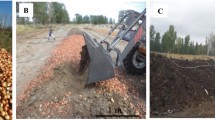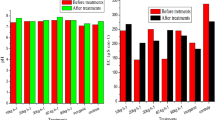Abstract
In a 2-year field experiment, the efficacy of five composts prepared from on-farm wastes lresidues of Calotropis procera (Willd) Dryland, Prosopis juliflora (Swartz) DC, Azadirachta indica A. Juss, Acacia nilotica (Linn) Willd ex. Del. and on-farm weeds on severity of dry root rot caused by Macrophomina phaseolina in relation to microbial population dynamics, microbial activity and on seed yield of guar was ascertained. In general, during crop growth compost amended plots retained 16 % higher soil moisture than non-amended plots. Populations of total fungi, bacteria and actinomycetes increased in the amended plots during the crop season. The maximum population of total fungi, actinomycetes and bacteria were recorded in A. nilotica, P. juliflora and weeds compost-amended treatments, respectively. Microbial activity was also 26.1 % higher in amended compared to non-amended plots. Amendment of soil with composts resulted in increases in the concentration of micronutrients and significant reduction in plant mortality due to dry root rot. Beneficial effects of composts were also discernible in yield promotion where 40 % increase in the seed yield was recorded in P. juliflora compost-amended plots. These results suggests that in arid regions of India, certain on-farm wastes can be effectively utilized for managing Macrophomina induced diseases besides enhancing crop productivity.


Similar content being viewed by others
References
Allievi L, Marchesini A, Salardi C, Piano V, Ferrari A (1993) Plant quality and soil residual fertility six years after a compost treatment. Bioresour Technol 43:85–89
Bareja M, Praveen Kumar, Lodha S (2010) Effect of composts on microbial dynamics and activity, dry root rot severity and seed yield of cowpea in the Indian arid region. Phytopathol Mediterr 49:381–392
Barrs HD (1968) Determination of water deficit in plant tissues. In: Kozlowoski TT (ed) Water deficits and plant growth. Academic, New York, pp 235–268
Bulluck IR, Ristaino JB (2002) Effect of synthetic and organic soil fertility amendments on southern blight, soil microbial communities and yield of processing tomatoes. Phytopatholgy 92:181–189
Bumbieris M, Lloyd AB (1966) Influence of soil fertility and moisture on lysis of fungal hyphae. Aust J Biol Sci 20:103–112
Burman U, Lodha S (2000) Macrophomina Infection and expression in relation to plant water status of arid legumes. J National Bot Soc 54:13–18
Craft CM, Nelson EB (1996) Microbial properties of composts that suppress damping-off and root rot of creeping bent grass caused by Pythium graminicola. Appl Environ Biol 62:1550–1557
Dhingra OD, Sinclair JB (1975) Survival of Macrophomina phaseolina sclerotia in soil: effect of soil moisture: carbon: nitrogen ratios, carbon sources and nitrogen concentrations. Phytopathology 65:236–240
Dhingra OD, Sinclair JB (1978) Biology and pathology of Macrophomina phaseolina. Universrsidade Federal de vicosa, MG, Brasil, pp 166
Gamliel A, Stapleton JJ (1993) Effect of chicken compost or ammonium phosphate and solarization on pathogen control, rhizosphere micro-organisms and lettuce growth. Plant Dis 77:886–891
Ghaffar A, Zentmeyer GA (1968) Macrophomina phaseolina on some new weed hosts in California. Plant Dis Reptr 52:223
Ghaffar A, Zentmeyer GA, Erwin DC (1969) Effect of organic amendments on severity of Macrophomina phaseolina root rot of cotton. Phytopathology 59:1267–1269
Ghasemian V, Ghalavand A, Soroosh zadeh A, Pirzad A (2010) The effect of iron, zinc and manganese on quality and quantity of soybean seed. J Phytol 2:73–79
Howard A, Ward YD (1931) The waste products of Agriculture and their utilization as humus. Oxford University Press, London
Khan HA, Lodha V, Ghanim A (1992) Triacontanol from leaves of Prosopis cineraria and Prosopis juliflora. Transaction ISDT 17:29–32
Lodha S (1996) Influence of soil moisture conservation techniques on Macrophomina phaseolina population, dry root rot and yield of guar. Indian Phytopath 49:342–349
Lodha S (1998) Effect of sources of inoculum on population dynamics of Macrophomina phaseolina and disease intensity in guar. Indian Phytopath 51:175–179
Lodha S, Gupta GK, Singh S (1986) Crop disease situation and some new records from Indian arid zone. Ann Arid Zone 25:311–320
Lodha S, Bohra MD, Harsh LN (1999) Evaluation of Prosopis pods as a source of carbohydrate for enhancing the growth of soil borne fungi. Indian Phytopath 52(1):24–27
Lodha S, Sharma SK, Aggarwal RK (2002) Inactivation of Macrophomina phaseolina propagules during composting and effect of composts on dry root rot severity and on seed yield of clusterbean. Eur J Plant Pathol 108:253–261
Lumsden RD, Lewis JA, Millner PD (1983) Effect of composted sewage sludge on several soil borne pathogens and diseases. Phytopathology 73:1543–1548
Mawar R, Lodha S (2006) Relative efficacy of on-farm weeds as soil- amendment for managing dry root rot of clusterbean in an arid environment. Phytopathol Mediterr 45:215–224
Meyer WA, Sinclair JB, Khare MN (1973) Biology of Macrophomina phaseoli in soil studied with selective media. Phytopathology 63:613–620
Mohan SS, Dhumal KN (2011) Role of micronutrients for improving yield and sennoside contents in traditional medicinal plant Cassia angustifolia. Int J Ayur Res Pharm 2:1303–1307
Montgomery DC (2008) Design and analysis of experiments. Wiley Student Edition, USA
Nelson EB, Craft CM (1992) Suppression of dollar spot on creeping bentgrass and annual blue grass turf with compost amended top dressings. Plant Dis 76:954–958
Patricia LS, Kshiesagar AM (1985) Testing for the equality of the variance-covariance matrices of two jointly normal vector variables. Biometrical J 24:581–589
Reddy MM, Padmaja B, Malathi, SL, Jalapathi Rao (2007) Effects of micronutrients on growth and yield of pigeon pea. SAT ejournal.icrisat.org
Santos GLC, Pereria MSV (1990) Utilization of P. juliflora as culture medium and as enriching source for phytopathogenic fungi culture. In: Habbit MA, Saavendra JC (eds) The current state of knowledge on Prosopis juliflora, FAO, Rome, pp 335–337
Scholander PF, Hammel EP, Brasstreet ED, Hammingsen EA (1965) Sap pressure in vascular plants. Science 148:339–346
Shahzad S, Sattar A, Ghaffar A (1988) Addition to the hosts of Macrophomina phaseolina. Pak J Bot 20:151–152
Sharma SK, Aggarwal RK, Lodha S (1995) Population changes of Macrophomina phaseolina and Fusarium oxysporum f. sp. cumini in oil cake and crop residue amended sandy soils. Appl Soil Ecol 2:281–284
Sinclair JB (1982) Compendium of soybean diseases, 2nd edn. Amer Phyopath Soc pp 104
Singh SK, Nene YL, Reddy MV (1990) Addition to the host range of Macrophomina phaseolina. Plant Dis 74:828
Snedecor GE, Cochran WJ (1967) Statistical methods. Oxford & IBH Publishing Co, Calcutta
Tabatabai MA (1982) Soil enzymes. In: Page AL, Keeney DR (eds) Methods of soil analysis. Part 2. Chemical and microbiological properties. Soil Science Society of America, Madison, pp 903–948
Vahid G, Amir G, Ali SZ, Alireza P (2010) The effect of iron, zinc and manganese on quality and quantity of soyabean seed. J Phytol 2:73–79
Young DJ, Alcorn SM (1984) Latent infection of Euphorbia lathyris and weeds by Macrophomina phaseolina and propagules populations in Arizona field soil. Plant Dis 68:587–589
Author information
Authors and Affiliations
Corresponding author
Rights and permissions
About this article
Cite this article
Bareja, M., Mawar, R., Mathur, M. et al. On –farm waste-based composts in managing Macrophomina phaseolina induced dry root rot of guar in an arid environment. Australasian Plant Pathol. 42, 9–16 (2013). https://doi.org/10.1007/s13313-012-0157-z
Received:
Accepted:
Published:
Issue Date:
DOI: https://doi.org/10.1007/s13313-012-0157-z




